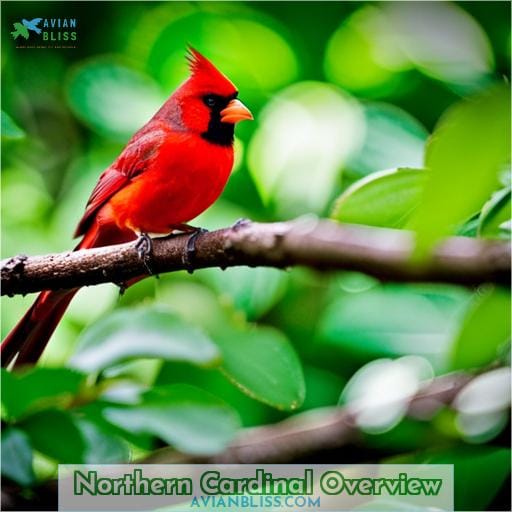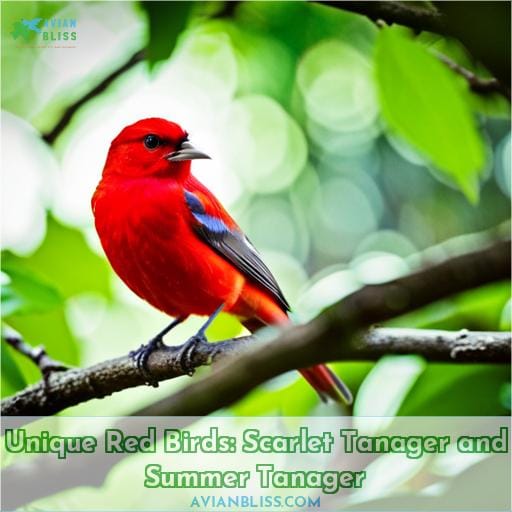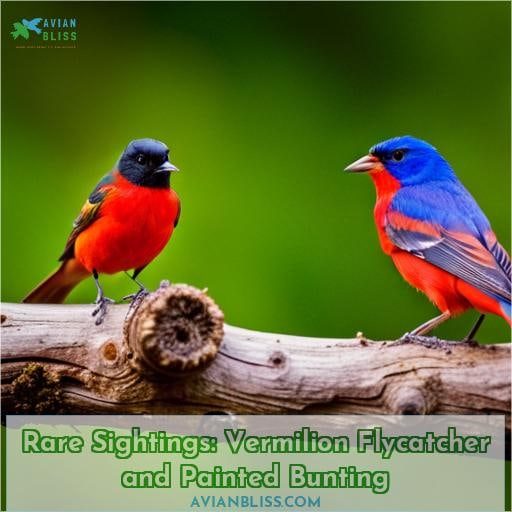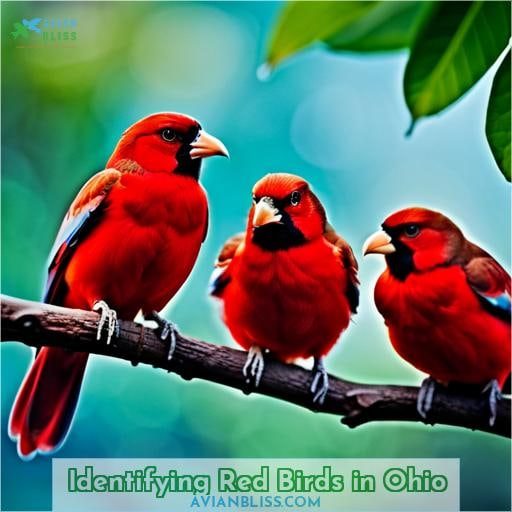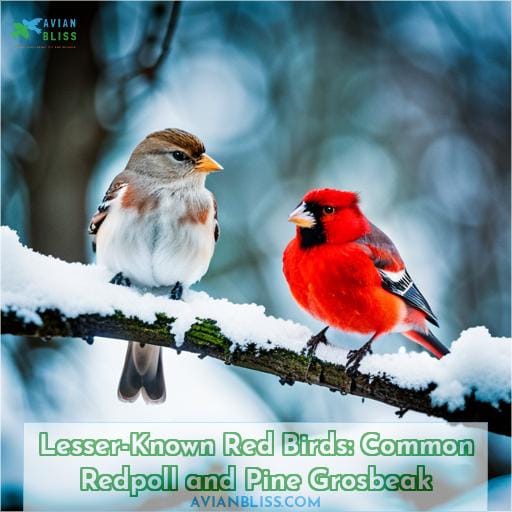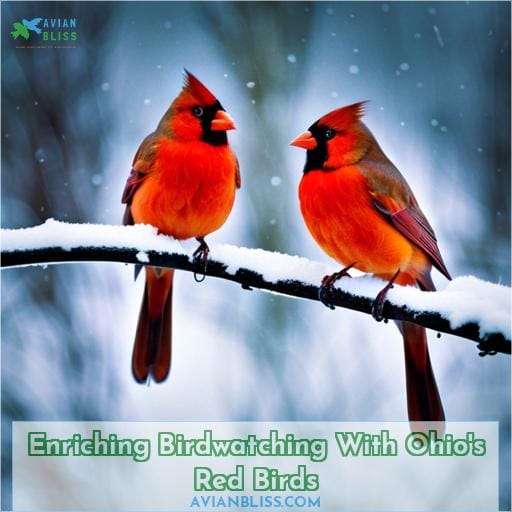This site is supported by our readers. We may earn a commission, at no cost to you, if you purchase through links.
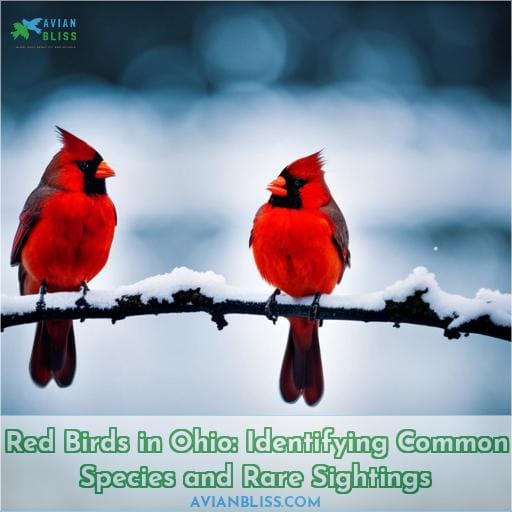
From the iconic Northern Cardinal to the elusive Vermilion Flycatcher, this comprehensive guide illuminates the scarlet-hued denizens that grace Ohio’s skies.
Picture the moment when a flash of crimson breaks through the emerald canopy – it’s not merely a bird; it’s a Northern Cardinal. With its distinctive black-masked visage and scarlet crown, this year-round Ohio inhabitant exudes an air of permanence in a world of fleeting feathers.
Venture further, and the House Finch’s rosy hues beckon, its subtle elegance contrasting the bold Cardinal. Amidst the avian chorus, the Red-Bellied Woodpecker emerges, adorned with fiery accents and a rhythmic drumming cadence that resonates through the woods.
Yet, the realm of Ohio’s red birds extends beyond the familiar. Imagine the secretive Scarlet Tanager, a fleeting glimpse of flame amidst the trees, or the Summer Tanager, its mango-red plumage concealing tales of transcontinental journeys.
Amidst the natural symphony, the resonant call of the Red-Headed Woodpecker strikes a chord, while the White-Winged Crossbill unveils its specialized bill designed for extracting sustenance from pine cones.
Rare apparitions bring further enchantment, such as the Vermilion Flycatcher, with its dashing scarlet allure, and the Painted Bunting, a living canvas of vivid pigments.
This realm of red holds more than just visual wonder; it offers the thrill of identification, the delight of observation, and the intimacy of shared space with these crimson-winged beings.
Whether you’re a novice seeking understanding or a seasoned enthusiast yearning for belonging, Ohio’s red birds invite you to partake in their vibrant tales, weaving a sense of unity between observer and observed, human and avian.
Table Of Contents
- Key Takeaways
- Northern Cardinal Overview
- Other Common Red Birds in Ohio
- Unique Red Birds: Scarlet Tanager and Summer Tanager
- Exploring Woodpeckers: Red-Headed Woodpecker and Red-Bellied Woodpecker
- Rose-Breasted Grosbeak and White-Winged Crossbill
- Rare Sightings: Vermilion Flycatcher and Painted Bunting
- Identifying Red Birds in Ohio
- Birdwatching Tips: Recognizing American Robin
- Lesser-Known Red Birds: Common Redpoll and Pine Grosbeak
- Enriching Birdwatching With Ohio’s Red Birds
- Conclusion
Key Takeaways
- Ohio’s bird population includes a diverse array of red-feathered species.
- Red birds in Ohio, such as the Northern Cardinal and Vermilion Flycatcher, add a splash of color to the state’s landscapes.
- Different bird families, such as the Cardinal Family, Finches, and Woodpeckers, Tanager Duo, and Specialized Birds, showcase unique characteristics and adaptations.
- Birdwatchers can enhance their experience by exploring various habitats, practicing patient observation, and using camouflage and strategic timing for photography.
Northern Cardinal Overview
Explore the diverse avian tapestry of Ohio by delving into the details of the Northern Cardinal, a year-round resident known for its vibrant plumage and vigorous territorial defense, which includes attacking reflections.
Notably, the males of this species can reach lengths of 8.3-9.1 inches and boast a wingspan of 9.8-12.2 inches. In Ohio, you can easily identify these red birds by their striking red plumage, while females sport a more subdued brown with red highlights.
When it comes to their feeding habits, Northern Cardinals are attracted to sunflower seeds, peanuts, millet, and milo, making them frequent visitors to backyard feeders.
In their quest to defend their territory, these cardinals exhibit assertive behavior, and their distinctive calls can be heard throughout the year. They’re known for fiercely protecting their nests from intruders, even challenging their own reflections in windows.
This captivating combination of fiery plumage, territorial dedication, and unique feeding preferences makes the Northern Cardinal a standout in Ohio’s rich avian community, a bird that provides an intimate glimpse into the state’s natural beauty.
Other Common Red Birds in Ohio
Turning your attention to other notable red birds residing in Ohio, you’ll encounter the House Finch and the Red-Bellied Woodpecker. The House Finch, with its distinct red head and breast on males and streaked brown plumage on females, exhibits remarkable adaptability to diverse habitats and is often seen congregating in groups.
Meanwhile, the Red-Bellied Woodpecker, despite its name, showcases only a subtle reddish tint on its belly, but its energetic foraging behaviors and distinctive churr calls make it a fascinating subject for behavioral analysis within Ohio’s avian community.
House Finch
Observe the House Finch, a common year-round presence with its males showcasing captivating head and breast hues, while females exhibit subtler brown-streaked plumage. Delight in their adaptable nature as they thrive in diverse habitats, often forming social groups.
Notice their fondness for bird feeders, where they enthusiastically partake in sunflower seed feasts. Marvel at their ability to breed multiple times a year, a testament to their tenacious survival strategies.
Red-Bellied Woodpecker
As you delve into the diverse avian inhabitants, your attention fixates upon the Red-Bellied Woodpecker. This striking species, with a vibrant red crown and nape, showcases intriguing behaviors. Its adaptable diet ranges from insects and fruits to nuts and seeds, exemplifying its habitat diversity.
Evident through its rolling calls and drumming, vocalizations serve communication and territorial assertion. Breeding habits involve cavity creation, an architectural marvel complementing nesting behavior in tree hollows.
Unique Red Birds: Scarlet Tanager and Summer Tanager
Delving into the realm of Ohio’s unique red bird species, direct your attention to the Scarlet Tanager, a vivid summer breeder. Males boast a vibrant crimson plumage with contrasting black wings and tails, while females exhibit a subtle yet appealing yellow hue.
Meanwhile, the Summer Tanager, also a summer visitor, stands distinct with its rich red body in males and yellow tint in females, and intriguingly, it supplements its diet with bees and wasps.
Scarlet Tanager Characteristics
Delve into the captivating world of the Scarlet Tanager, a mesmerizing creature with vibrant hues that adorn the treetops and contribute to the rich tapestry of Ohio’s avian diversity.
Scarlet Tanager Characteristics:
Diet: This bird’s menu consists of insects and fruits, making it an essential player in maintaining the ecological balance by controlling insect populations and aiding in seed dispersal.
Habitat: Found in the canopies of deciduous and mixed forests, its preference for high treetops showcases its elusive nature.
Migration: Embarking on a lengthy migration to Central and South America during winter, these birds travel great distances to find suitable climates and resources.
Breeding: Breeding in summer, the male’s vivid red plumage is a beacon during courtship, while females build nests in well-concealed locations.
Vocalization: Its song, a hoarse but melodic series of phrases, resonates through the treetops, adding to the enchanting chorus of Ohio’s birdlife.
Summer Tanager Features
Immerse yourself in the realm of avian diversity as you explore the distinct traits of the Summer Tanager, a captivating visitor to the state, displaying a vibrant hue that sets it apart from its fellow winged inhabitants.
| Traits | Insights | Observations |
|---|---|---|
| Nesting Habits | Meticulously builds cup nests | Nests are usually found in tall trees |
| Migratory Patterns | Summer resident, migrates to Central/South America | Notable for its long migrations |
| Feeding Preferences | Feasts on bees, wasps | Unique diet compared to local birds |
| Vocalizations | Warbling, melodious song | Distinguished calls attract attention |
Summer Tanagers, with their warbling songs and fiery plumage, grace Ohio during summer, adding an element of rarity to backyard bird watching. Understanding their behaviors and preferences satisfies the innate curiosity for belonging and intimacy with these splendid creatures.
Exploring Woodpeckers: Red-Headed Woodpecker and Red-Bellied Woodpecker
Turning our focus to woodpeckers, particularly within the realm of red birds in Ohio, we delve into the distinctive traits of the Red-Headed Woodpecker. This species stands out with its striking crimson head, contrasting starkly against a snow-white body, while its foraging behaviors and habitat preferences unveil intriguing facets of its ecological niche.
Notably, the Red-Bellied Woodpecker, despite its misleading name, showcases an intriguing behavior of storing food in crevices and tree bark, offering an intriguing glimpse into its adaptive strategies for survival in the intricate woodland environment.
Red-Headed Woodpecker Traits
Roaming through the realm of these vibrant avian residents, you’d find the Red-Headed Woodpecker, showcasing its own set of distinctive traits.
Behavior: This woodpecker is an acrobatic marvel, often observed clinging to tree trunks and branches while foraging for insects.
Habitat: It prefers open woodlands, savannas, and orchards, where dead trees provide nesting sites and open spaces allow it to hunt insects in flight.
Diet: Known for its opportunistic palate, it consumes insects, fruits, nuts, and even small vertebrates, displaying remarkable adaptability.
Conservation: While populations are relatively stable, the loss of mature trees and suitable foraging areas can impact its numbers.
Breeding: Red-Headed Woodpeckers exhibit territorial behavior during the breeding season, drumming on trees and engaging in aerial displays to attract mates.
Red-Bellied Woodpecker Behavior
Discover how the intriguing behavior of the Red-Bellied Woodpecker adds a dynamic layer to the tapestry of avian life in this region. These birds exhibit resourcefulness in foraging, deftly exploring tree bark for insects, fruits, and seeds.
Their distinctive calls, a medley of churring and chattering, echo through the Ohio woods, creating a sense of belonging to the natural soundscape. This adaptable species thrives in various habitats, a testament to their capacity for intimacy with their environment.
Rose-Breasted Grosbeak and White-Winged Crossbill
Delve into the avian tapestry of Ohio, where intricate behaviors and plumage hues converge. Witness the courtship ballet of the Rose-Breasted Grosbeak, as the males, adorned in jet-black and white, execute elegant displays to woo their delicately streaked mates.
Meanwhile, the enigmatic White-Winged Crossbill, a rare winter visitor, navigates the coniferous realm with its distinctive curved bill, engineered to expertly extract seeds, a mastery finely tuned through evolutionary epochs.
Rose-Breasted Grosbeak Details
Picture the vibrant and striking Rose-Breasted Grosbeak, a visitor that graces the woodlands with its colorful plumage during certain seasons.
Behavior: The male Rose-Breasted Grosbeak’s melodic song resonates through the trees, a courtship serenade that communicates vitality and readiness for mating.
Habitat: These grosbeaks favor edge habitats, where woodlands meet open areas, seeking both seclusion and accessible foraging grounds.
Migration: With the changing seasons, they embark on remarkable journeys, migrating across the Americas, from as far north as Canada to as south as Central America.
Breeding: Their nests, ingeniously woven with grass and leaves, cradle the delicate eggs, marking the beginning of another generation’s cycle.
Intimacy: Witnessing these grosbeaks reveals nature’s delicate balance, igniting a sense of belonging as you observe their harmonious existence amidst the trees.
White-Winged Crossbill Insights
Immerse yourself in the lesser-known realms of Ohio’s avian inhabitants as you delve into the captivating tale of the White-Winged Crossbill, a visitor that adds a unique melody to the state’s vibrant symphony of feathered residents.
Adaptations:
- Specialized bill crossed at tips: aids in prying conifer scales and allows access to nutritious seeds.
- Feeding Habits:
- Efficiently extracts seeds from conifer cones.
- Feeds while hanging upside-down.
- Consumes vast amounts of seeds daily.
Habitat Preferences:
- Thrives in coniferous forests.
- Prefers spruce, pine, and fir.
- Breeds year-round and forms flocks.
- Vocalizations:
- Melodic, trilling calls.
- High-pitched flight calls.
- Calls aid flock cohesion.
Witness its population trends:
The White-Winged Crossbill’s numbers can fluctuate greatly, depending on the availability of conifer seeds. These fluctuations are driven by cone crops, making its population unpredictable from year to year.
Join this melodious wanderer in its coniferous haven, an embodiment of nature’s harmonious dance.
Rare Sightings: Vermilion Flycatcher and Painted Bunting
Introducing the rare avian denizens of Ohio’s skies, the Vermilion Flycatcher and the Painted Bunting, both flaunt resplendent red hues that elicit fascination among bird enthusiasts. The Vermilion Flycatcher, with its vivid crimson front and contrasting brown dorsal plumage, graces the southern territories, demonstrating its adeptness in snatching insects mid-flight from its desert perch.
Meanwhile, the Painted Bunting, a winter visitor with males adorned in a kaleidoscope of vibrant colors and females exhibiting subdued yellow-green tones, embarks on a journey from select U.S. states to Central America, nourishing itself with a diet encompassing seeds and insects.
Vermilion Flycatcher Traits
Imagine encountering a creature with a vibrant front as bright as a desert bloom, set against a backdrop of earthy browns—a fleeting glimpse of nature’s artistry that graces Ohio’s landscapes. The Vermilion Flycatcher, a rare winter visitor, brings a touch of the exotic to the state.
With its striking red plumage and brown back, it blends beauty and functionality. Inhabitants of desert landscapes, these flycatchers display agile behavior, deftly catching insects while perched. Their vivid appearance, coupled with their distinctive hunting style, lends an air of intrigue to Ohio’s avian tapestry.
Painted Bunting Characteristics
Explore the enchanting world of the Painted Bunting as it reveals its vibrant and varied plumage, reflecting nature’s artistry in Ohio’s avian landscape. This avian gem graces the state as a rare winter visitor, boasting stunningly colorful feathers.
Found primarily in the southern regions, it’s a mesmerizing sight against the backdrop of arid desert landscapes. Its migration patterns offer a fleeting glimpse, adding to the allure of its presence.
Identifying Red Birds in Ohio
Exploring the realm of red birds in Ohio delves into a world of avian diversity. By utilizing range maps, you can decipher the distribution of these crimson-hued species, while mastering the art of attracting them to your backyard requires a careful choreography of sustenance and habitat provisions.
Using Range Maps
Discover how utilizing range maps can unveil the geographical distribution of these captivating species, shedding light on their presence across diverse landscapes. By meticulously analyzing their habitats, migration patterns, and seasonal distribution, researchers gain invaluable insights into the intricate tapestry of their lives.
This knowledge is pivotal for targeted conservation efforts, safeguarding the habitats of these red birds and ensuring their survival for generations to come.
Attracting Red Birds to Your Backyard
To create an inviting haven for these crimson-hued avian residents, consider adorning your backyard with an assortment of sunflower seeds, peanuts, and millet, which could entice these vibrant flyers to pay you a delightful visit.
Red bird feed preferences vary, but providing a mix of these nutritious seeds can attract species like cardinals, finches, and tanagers. Enhance their stay by adding birdhouses and maintaining a bird-friendly landscape that caters to their seasonal migration patterns.
Birdwatching Tips: Recognizing American Robin
As you immerse yourself in the world of Ohio’s red birds, your journey through birdwatching takes a delightful turn towards the beloved American Robin. This familiar bird, often associated with the arrival of spring, presents a unique set of behaviors and patterns that captivate both novice and seasoned observers.
American Robin Behavior
Engage in patient observation as you witness the American Robin’s distinctive behaviors:
Morning Serenades: Experience the joy of early mornings as robins fill the air with their melodious, cheerful songs.
Foraging Feats: Observe their agile hopping and pausing techniques as they search for earthworms and insects.
Nesting Wonders: Gain an intimate understanding of their nesting habits, from selecting sturdy branches to crafting intricate nests.
Vigilant Guardianship: Witness the dedicated robin parents as they fiercely protect their nests from potential threats.
By practicing these Robin Watching Techniques, you can harmonize with their world and delve into their realm of activities. Listen closely to their Robin Vocalizations, each chirp conveying a specific message of territory or warning. Discover their Robin Feeding Patterns, as they alternate between hopping and stillness during foraging.
As you become attuned to these nuances, a sense of belonging envelops you, linking you to the lives of these red-hued inhabitants. Your observations unveil the intricacies of their existence, while their presence fosters an intimacy with the natural world.
Lesser-Known Red Birds: Common Redpoll and Pine Grosbeak
Delving into the realm of lesser-known red birds, direct your gaze to the common redpoll, a winter visitor of Ohio. This diminutive creature exhibits an intriguing behavior, devouring up to 42% of its body mass in seeds, a testament to its resourceful feeding strategy.
Shift your focus to the pine grosbeak, a rare winter guest adorned with red plumage and gray wings, seeking refuge in the coniferous forests of the Canadian wilderness.
Common Redpoll Behavior
Explore the intriguing behavior of the Common Redpoll, a winter visitor recognized by its distinctive red forehead and pink breast. These birds are known to consume up to 42% of their body mass in seeds, displaying remarkable winter survival strategies through their voracious feeding habits.
The plumage variation of Common Redpolls is notable, with varying degrees of red and streaking on their chests.
Social interactions among Common Redpolls are fascinating. They often form tight-knit flocks and exhibit coordinated movements while foraging.
These birds have a strong preference for weedy fields and areas abundant in catkins.
Pine Grosbeak Habits
Delving into Pine Grosbeak’s habits, imagine these robust creatures traversing the woodlands with their striking plumage and penchant for feasting on seeds and fruits. In winter, they exhibit remarkable adaptations, with an ability to subsist on a diet primarily composed of buds when seeds are scarce.
Their breeding range in the Canadian forests of pine, spruce, and fir showcases their resilience in harsh environments. Watch as they forage meticulously, displaying varying plumage that adds to their mystique.
Enriching Birdwatching With Ohio’s Red Birds
Enhance your birdwatching experience by discovering the diverse array of vibrant feathered inhabitants found throughout Ohio, adding a touch of natural beauty to your outings.
Habitat Diversity: Explore various ecosystems, from dense forests to open woodlands, to encounter different red bird species.
Patient Observation: Spend time in birding hotspots, like Hocking Hills and Magee Marsh, where red birds often gather.
Camouflage Mastery: Blend into your surroundings to get intimate glimpses of these shy creatures in their natural habitat.
Strategic Timing: Early mornings and late afternoons provide optimal lighting for exquisite red bird photography.
Seasonal Migration: Observe the arrival and departure of migrant species, like the Vermilion Flycatcher, for an extraordinary experience.
Ohio’s avian gems offer a sense of belonging and intimacy with nature, while understanding their behaviors adds depth to your birdwatching adventures.
Conclusion
Concluding our ornithological exploration of Ohio’s scarlet-hued avian residents, it becomes evident that the vibrant tapestry of red birds enriches the state’s diverse ecosystems. From the fiery elegance of the Northern Cardinal to the elusive charm of the Vermilion Flycatcher and Painted Bunting, these crimson-feathered denizens exemplify nature’s palette.
Employing meticulous identification techniques and strategic habitat enhancements can bring these red-winged wonders to your doorstep. With their varied traits and behaviors, these red birds in Ohio are an awe-inspiring testament to avian splendor.

